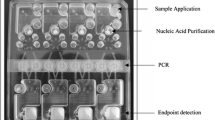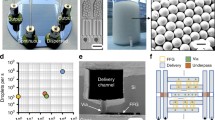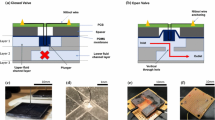Abstract
Much previous work in methods of achieving complex drug-release patterns has focused on pulsatile release from polymeric materials in response to specific stimuli1, such as electric2,3,4,5 or magnetic6,7 fields, exposure to ultrasound7,8, light9 or enzymes10, and changes in pH11 or temperature12,13,14. An alternative method for achieving pulsatile release involves using microfabrication technology to develop active devices that incorporate micrometre-scale pumps, valves and flow channels to deliver liquid solutions15,16. Here we report a solid-state silicon microchip that can provide controlled release of single or multiple chemical substances on demand. The release mechanism is based on the electrochemical dissolution of thin anode membranes covering microreservoirs filled with chemicals in solid, liquid or gel form. We have conducted proof-of-principle release studies with a prototype microchip using gold and saline solution as a model electrode material and release medium, and we have demonstrated controlled, pulsatile release of chemical substances with this device.




Similar content being viewed by others
References
Kost, J. & Langer, R. Responsive polymeric delivery systems. Adv. Drug Delivery Rev. 6, 19–50 (1991).
Kwon, I. C., Bae, Y. H. & Kim, S. W. Electrically erodible polymer gel for controlled release of drugs. Nature 354, 291–293 (1991).
Bae, Y. H., Kwon, I. C. & Kim, S. W. in Polymeric Drugs and Drug Adminsitration (ed. Ottenbrite, R. M.) 98–110 (Am. Chem. Soc., Washington DC, (1994)).
Miller, L. L. Electrochemically controlled release of drug ions from conducting polymers. Mol. Cryst. Liq. Cryst. 160, 297–301 (1988).
Hepel, M. & Fijalek, Z. in Polymeric Drugs and Drug Adminsitraiton (ed. Ottenbrite, R. M.) 79–97 (Am. Chem. Soc., Washington DC, (1994)).
Edelman, E. R., Kost, J., Bobeck, H. & Langer, R. Regulation of drug release from polymer matrices by oscillating magnetic fields. J. Biomed. Mater. Res. 19, 67–83 (1985).
Kost, J. & Langer, R. in Pulsed and Self-Regulated Drug Delivery (ed. Kost, J.) 3–16 (CRC, Boca Raton, (1990)).
Kost, J., Leong, K. & Langer, R. Ultrasound-enhanced polymer degradation and release of incorporated substances. Proc. Natl Acad. Sci. USA 86, 7663–7666 (1989).
Mathiowitz, E. & Cohen, M. D. Polyamide microcapsules for controlled release. V. Photochemical release. J. Membr. Sci. 40, 67–86 (1989).
Fischel-Ghodsian, F., Brown, L., Mathiowitz, E., Brandenburg, D. & Langer, R. Enzymatically controlled drug delivery. Proc. Natl Acad. Sci. USA 85, 2403–2406 (1988).
Siegel, R. A., Falamarzian, M., Firestone, B. A. & Moxley, B. C. pH-controlled release from hydrophobic/polyelectrolyte copolymer hydrogels. J. Control. Release 8, 179–182 (1988).
Bae, Y. H., Okano, T., Husu, R. & Kim, S. W. Thermo-sensitive polymers as on-off switches for drug release. Makromol. Chem. Rapid Commun. 8, 481–485 (1987).
Hoffman, A. S., Afrassiabi, A. & Dong, L. C. Thermally reversible hydrogels: II. Delivery and selective removal of substances from aqueous solutions. J. Control. Release 4, 213–222 (1986).
Okano, T., Bae, Y. H. & Kim, S. W. in Pulsed and Self-Regulated Drug Delivery (ed. Kost, J.) 17–45 (CRC, Boca Raton, (1990)).
Gravesen, P., Branebjerg, J. & Jensen, O. S. Microfluidics - a review. J. Micromech. Microeng. 3, 168–182 (1993).
Shoji, S. & Esashi, M. Microflow devices and systems. J. Micromech. Microeng. 4, 157–171 (1994).
Wolf, S. & Tauber, R. N. Silicon Processing for the VLSI Era Vol. 1 Process Technology (Lattice Sunset Beach, California, (1986)).
Jaeger, R. C. Introduction to Microelectronic Fabrication (Addison-Wesley, Reading, Massachusetts, (1988).
Frankenthal, R. P. & Siconolfi, D. J. The anodic corrosion of gold in concentrated chloride solutions. J. Electrochem. Soc. 129, 1192–1196 (1982).
Merchant, B. Gold, the noble metal and the paradoxes of its toxicology. Biologicals 26, 49–59 (1998).
Jiran, E. & Thompson, C. V. Capillary instabilities in thin, continuous films. Thin Solid Films 208, 23–28 (1992).
Wu, B. M. in Microstructural Control During Three Dimensional Printing of Polymeric Medical DevicesThesis, 25–40 MIT((1997)).
Acknowledgements
We thank A. Göpferich and M. Llabres for help in the early stages of the project, and K. Jensen, C. Thompson and R. Latanision for discussions about materials and electrochemical aspects of this project. All fabrication work was carried out at the Microsystems Technology Laboratory at MIT. This work was partially supported by the US NSF.
Author information
Authors and Affiliations
Corresponding author
Rights and permissions
About this article
Cite this article
Santini, J., Cima, M. & Langer, R. A controlled-release microchip. Nature 397, 335–338 (1999). https://doi.org/10.1038/16898
Received:
Accepted:
Issue Date:
DOI: https://doi.org/10.1038/16898
- Springer Nature Limited
This article is cited by
-
Digital automation of transdermal drug delivery with high spatiotemporal resolution
Nature Communications (2024)
-
Wireless on-demand drug delivery
Nature Electronics (2021)
-
Nitinol actuated soft structures towards transnasal drug delivery: a pilot cadaver study
Medical & Biological Engineering & Computing (2020)
-
Recent Advances in Anti-inflammatory Strategies for Implantable Biosensors and Medical Implants
BioChip Journal (2020)





